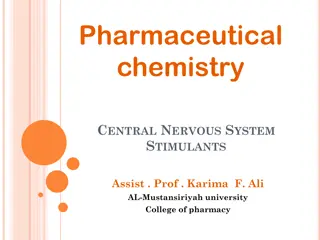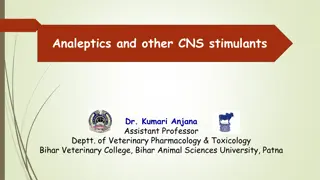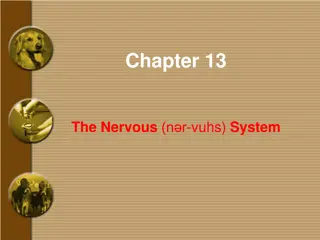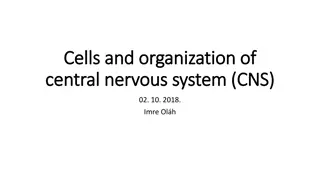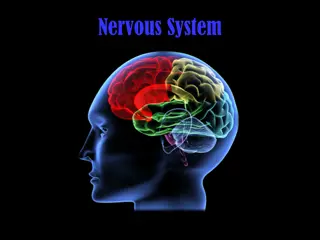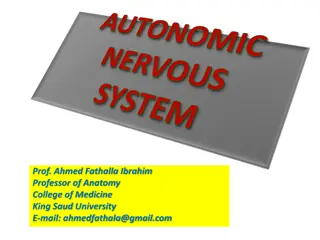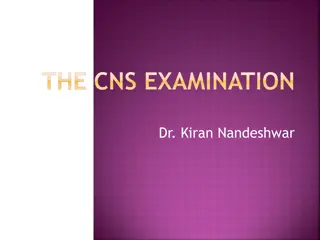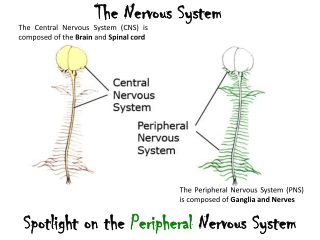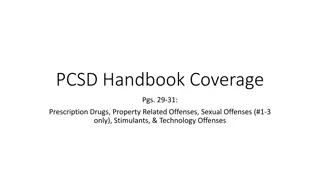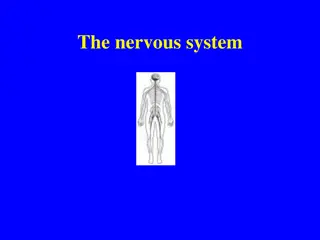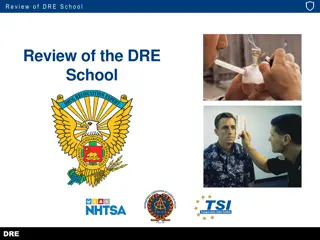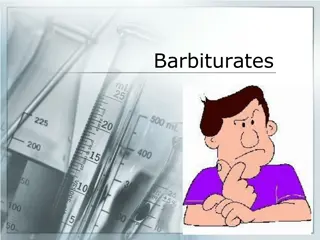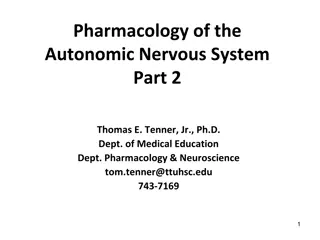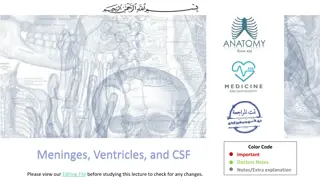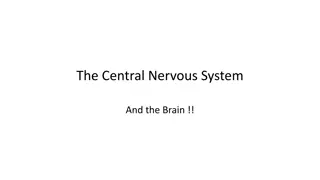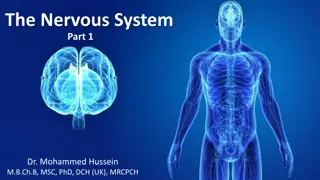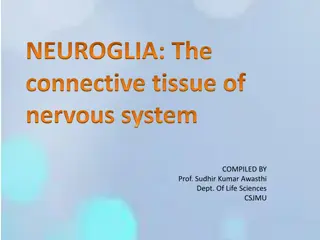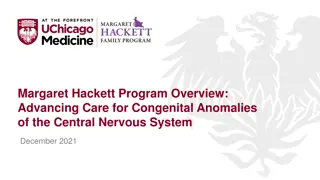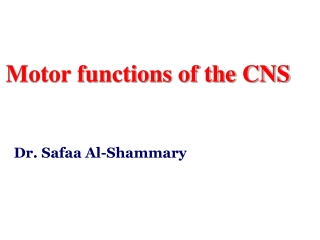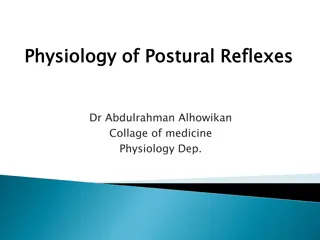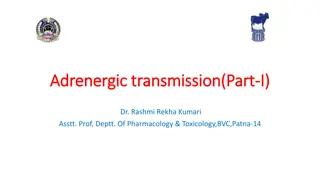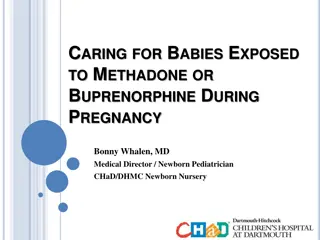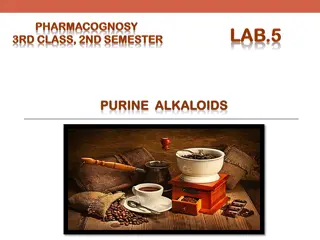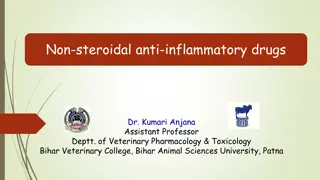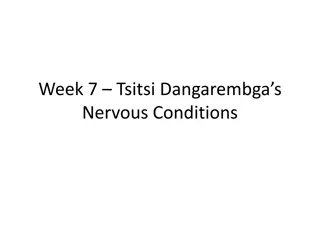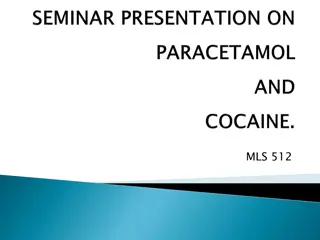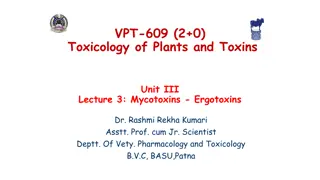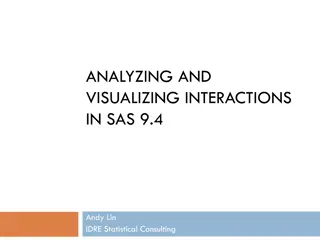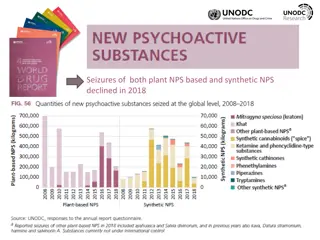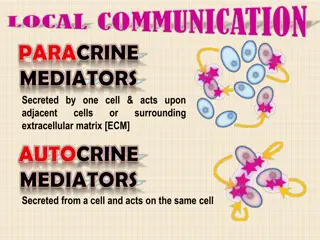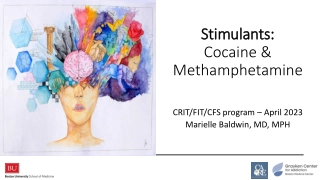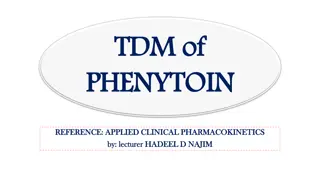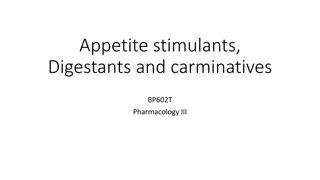Understanding CNS Stimulants and Their Effects on the Nervous System
Exploring the world of central nervous system stimulants, this content delves into the mechanisms of action of stimulant drugs, highlights the neurotransmitters involved, and discusses the signs and symptoms of CNS stimulation. It covers the use of amphetamine in conditions like narcolepsy, attention-deficit hyperactivity disorder (ADHD), and simple obesity. Additionally, it touches on lab animal use in pharmacology studies and restraint methods for mice in research settings.
Download Presentation

Please find below an Image/Link to download the presentation.
The content on the website is provided AS IS for your information and personal use only. It may not be sold, licensed, or shared on other websites without obtaining consent from the author. Download presentation by click this link. If you encounter any issues during the download, it is possible that the publisher has removed the file from their server.
E N D
Presentation Transcript
Introduction and CNS stimulants Mohammed A. Alyami Head Teaching Assistant Department of Pharmacology & Toxicology College of Pharmacy KSU E-mail : maalyami@ksu.edu.sa
Lab Animals will be used in PHL 322, 326 Mouse Animal expression 058 http://www.criver.com/SiteCollectionImages/Images_255x164/rms_rat_white1_0013_lres.jpg http://t3.gstatic.com/images?q=tbn:ANd9GcSTFyO4AihrOYarcGoZqzNTJO76LPP_JhC4hIjjcpCn397wtblr Mouse Rat Frog
Restraint of mouse A. Tail Restraint Used for : transferring animals from cage to cage. B. Scruff Restraint Injections blood withdrawal. Used for : Intraperitoneal Injections ( IP ) - Restrain the mouse by the scruff method.
CNS stimulant drugs Lab# 1
Neuron They are the basic functional units of the nervous system. - They contain three major parts 1- Cell Body 2- Dendrites 3- Axons 3 Axon terminal Effector 1 2 Synapse Is the site where the axon of a neuron communicates with effectors or other neurons.
Neurotransmitter Neurotransmitter Aspartic acid Excitatory Neurotransmitter Glutamic acid Excitatory Neurotransmitter GABA inhibitory Neurotransmitter Glycine inhibitory Neurotransmitter
CNS stimulants Definition: Stimulants are substances which tend to increase behavioral activity when administered Signs and symptoms of CNS stimulation : 1- Elevate Mood. 2- Increase Motor Activity. 3- Increase Alertness. 4- Decrease need for Sleep.
1- Amphetamine MOA: Block the reuptake of Norepinephrine and Dopamine into the presynaptic neuron and increase the release of these Monoamines into the extraneuronal space. Clinical use: 1. Narcolepsy. 2. Attention-deficit hyperactivity disorder (ADHD) 3. Simple obesity
Signs and Symptoms: After injecting the mice with Amphetamine, you will notice: 1- Hair erection. 2- Licking, gnawing. 3- Stereotype. 4- Sniffing.
2- Picrotoxin MOA: Non-competitive antagonist of GABA receptors. After injecting the mice with Picrotoxin, you will notice: Clonic Convulsion characterized by : 1. Asymmetric 2. Intermittent 3. Spontaneous 4. Coordinated
3- Strychnine MOA: Competitive antagonist of the Glycine receptors. After injecting the mice with Strychnine, you will notice: Tonic convulsion characterized by : 1. Symmetric 2. Reflex in origin 3. Continuous 4. Uncoordinated.
Site of action Drug MOA Signs and symptoms 1- Hair erection. 2- Licking, gnawing. 3- Stereotype. 4- Sniffing. Clonic Convulsion characterized by 1. Asymmetric 2. Intermittent 3. Spontaneous 4. Coordinated Blocking the neurotransmitters reuptake and Promoting the release of neurotransmitters Cerebral Stimulants Amphetamine Medullary Stimulants Picrotoxin antagonist of GABA receptors Tonic convulsion characterized by : 1. Symmetric 2. Reflex in origin 3. Continuous 4. Uncoordinated Competitive antagonist of the Glycine receptors Spinal Stimulants Strychnine
CNS depressants LAB 2
A stimulant is a drug that speeds up activities of the CNS A depressant is a drug that slows brain and body reactions Depressants decrease Stimulants increase Heart rate Respiratory rate Increase Motor Activity. Increase Alertness. Decrease need for Sleep Relax muscle tension Lower alertness Cause drowsiness Blood pressure
Is inhibitory neurotransmitter. GABA Receptors GABA B GABA A Ligand-gated ion channel (ionotropic receptors) Metabotropic receptors
GABA A ( Chloride ion channel) CI - CI - CI - Prevent action potential CI - CI - CI - CI - CI - Cl- conductance Hyperpolarization of membrane
General Anesthesia General anesthetics Inhaled IV Gas Volatile liquids Barbiturates Benzodiazepines (nitrous oxide) (halothane) (thiopental) (midazolam) Opioids Dissociative MOA of Inhaled anesthetics, barbiturates, benzodiazepines, etomidate, and propofol are facilitate GABA-mediated inhibition at GABAA receptors. (fentanyl) (ketamine) Miscellaneous Its antagonism of the action of glutamic acid on the NMDA receptor (etomidate, propofol)
Sedative-Hypnotic Drugs Sedation : reduction of anxiety Hypnosis : induction of sleep Sedative = anxiolytic = antianxiety = minor tranquilizer : a drug that reduce anxiety Increase the dose of sedative that will lead to hypnosis 1. 2. 3. 4. Clinical use of Sedative-Hypnotic Drugs Anxiety Sleep disorder Antiseizure Anesthesia protocol
Sedative-hypnotics Miscellaneous agent Benzodiazepine Barbiturates Chloral hydrate .etc.
Tranquilizer Major tranquilizer = Antipsychotic Example Chlorpromazine (CPZ) MOA : Work by blocking dopamine (D 2 )receptor.
Work lab To demonstrate the effect of different types of CNS depressants as : - Hypnotics. Phenobarbital - Sedatives. Chloral hydrate (at sedative dose) - Tranquilizers. CPZ To learn how to distinguish between their signs if they are given as unknown drugs.
Righting reflex righting reflex the ability of the mice to assume an optimal position when there has been a departure from it. Is widely used to screen compounds with sedative properties If it isn t lost Righting reflex ------- +ve If it s lost Righting reflex ------- - ve
1- Phenobarbital Hypnotic drug After injection of Phenobarbital we can observe : Loss of righting reflex ( -ve) 2- chloral hydrate Sedative drug When the dose increased they will induce sleep. After injection of chloral hydrate we can observe : NO loss righting reflex (+ve)
CPZ After injection of CPZ we can observe signs such as: No loss of righting reflex (+ ve) Ataxic gait: loss of muscle coordination . Catalepsy : rigid body Creeping gait When you trying to put the mice on the cord, the mice will fall down Grasping test (CPZ):
Sensory or afferent neurons Neurons carrying impulses (AP) from sensory receptor (at PNS) to the CNS Cell body Unipolar neuron carrying impulses AP Spinal cord
Sensory or Afferent Type A fibers C fibers Non- myelinated Myelinated High conduction velocity Low conducting velocity Cause a sharp pain Cause a dull burning pain Cause localized pain Cause non-localized pain Pain receptor (Nociceptors) are cells nerve ending that initiate the sensation of pain Sensory Receptor Can be activated by : I. Chemical stimuli II. Thermal stimuli III. Mechanical stimuli This process, called nociception Noxious Stimuli An actually or potentially tissue damaging event
cell membrane phospholipids phospholipases A2 Arachidonic acid COX-2 Noxious Stimuli Prostaglandin E2 (PGE2) Sensitizes nociceptors to bradykinin (BK) , ((the most potent pain producing chemical)) and other pain mediators like substance P histamine, 5-HT etc. Release of endogenous opioid peptide ( endorphin) which cause inhibiting of nociceptive impulse( Modulation ) - For stimulation nociceptors, and lead to production of AP Then transmission the impulse to spinal cord and cortex (perception)
Without Pain Pain killer Analgesics Are medicines or drugs that relieve pain (analgesia). Analgesic Opioid agent Non-opioid agent Other agent e.g. NSAID Local anesthetics
Opioid Analgesics Contains many alkaloids morphine Opium Opiate : A drug derived from alkaloids of the opium Interaction with opioid receptor Opioid : the class of drugs that includes opiate, and all synthetic and semisynthetic drugs that mimic the action of opiate Antagonists e.g. Naloxone Mixed agonist- antagonists e.g. nalbuphine Agonists Strong: morphine Moderate : codeine weak: propoxyphene
opioid receptor - It s G protein-coupled receptor. - Three types 1- (mu) Most of the analgesic opioids are -receptor agonists Responsible for some major unwanted effects (e.g. respiratory depression, euphoria, sedation and dependence) 2- (kappa) 3- (delta)
Non Opioid Analgesics Non- Steroidal Anti-Inflammatory Drugs Arachidonic acid NSAID COX-1 COX-2 - NSAID - Thromboxane Prostacyclin Prostaglandins
Cox-2 selective inhibitor (coxib) Cox non-selective inhibitors Example : - Aspirin, - Ibuprofen, - Diclofenac etc Example - Celecoxib Thrombosis GI ulcer
LAB WORK Objective : To show the analgesic effects of different analgesics using different methods. I. II. Hot plate method. Writhing test.
Procedure: 4.Compare the number of writhing for each drug and comment on the results: A drug has less number of writhing that has more potency as analgesic. No. of writhing/20 minutes Drug Control Acetic cid 5 min s Test 1 Morphine acetic acid Aspirin acetic acid 5 min s Test 2
Hot plate method principle: The paws of the mouse are very sensitive to heat at temperature which are not damaging the skin . At temperature of 55 C the mouse will jump and licking the paws. The time till these response occur is calculated and is prolonged after administration of analgesics. Hot Plate Analgesia Meter
It is a reaction of living tissue to an injury. Types Acute Rapid onset , Short duration Chronic Gradual onset , long duration Cardinal signs of acute inflammation: 1.Redness 2.Hotness 3.Swelling 4.Pain and tenderness
Inflammatory Mediators Mediator Main activity Vasodilation, increase permeability Histamine Prostaglandins ( PGs ) Vasodilation, pain, fever Leukotrienes (LKs) Increase permeability Bradykinin Vasodilation, increase permeability, pain
Inflammatory process (( vascular phase)) Tissues damage Release inflammatory mediators a.Histamine b.PGE2 c.LKs d.Bradykinin Vasodilation (V.D.) Increase blood flow Increase vascular permeability lead to formation of fluid exudate((plasma protein)) Edema Formation
Inflammatory process Cardinal signs of acute inflammation: 1.Redness: due to Vasodilation 2.Hotness: due to Vasodilation and increase blood flow 3.Swelling: due to vascular leakage 4.Pain and tenderness: due to irritation by chemical mediators and pressure of swelling Aiming of the inflammation response (1) prevents the spread of damaging agents to nearby tissues, (2) disposes of cell debris and pathogens, and (3) sets the stage for repair.
Steroidal Non-steroidal Glucocorticoids NSAIDs like - Aspirin - aspirin don t contain steroid moiety Containing steroid moiety
Adrenal gland Secreted glucocorticoids from adrenal cortex glucocorticoids : are steroids hormones which include cortisone and cortisol (also called hydrocortisone) cortisol : is predominant glucocorticoids in human
GLUCOCORTICOIDS Clinical uses A- adrenal disorders: like Addison's disease B- Nonadrenal disorders : a. Anti-inflammatory for treatment asthma as example b. Immunosuppression: to prevent organ transplant rejection c. ..etc. Synthetics Prednisone Dexamethasone Natural - Cortisol - Cortisone One of the MOA They act by indirect inhibition of the enzyme phospholipase A2 by induce synthesis of a protein lipocortin-1 which has the inhibitory effect on phospholipase A2. Some Adverse Effects - Hyperglycemia - Osteoporosis - Moon face, buffalo hump
Non- Steroidal Anti-Inflammatory Drugs Cox-2 selective inhibitor (coxib) Cox non-selective inhibitors Example : - Aspirin, - Ibuprofen, - Diclofenac etc Example - Celecoxib ((has a FDA initiated black box warning concerning cardiovascular risk)) MOA Inhibit synthesis of PGs through inhibition of COX
Compare between Glucocorticoids &NSAID glucocorticoids NSAID Containing steroid moiety in their structure They don t contain steroid moiety Powerful anti-inflammatory , immunosuppression, adrenal disorder anti-inflammatory, analgesic, antipyretic anti-platelet ((only aspirin)) Prevent synthesis of LKs and PGs Prevent synthesis of PGs Treatment of asthma Can be caused asthma
Measurement the activity of anti-inflammatory drugs Method : Paw Oedema Method Equipment : Plethysmometer Principle : Induction a chemical inflammation by injecting an irritant ( formalin ) into rat s paw Objective : Measure the anti-inflammatory activity of aspirin and hydrocortisone (cortisol) with different doses
-Procedure : 1- select 5 rats 2- inject each rat 1 ml urethane for anesthesia. 3- select one as control and inject the rest of them Intraperitoneal (IP) rat 1 >>> control rat 2 >>> 40 mg/kg aspirin rat 3 >>> 80 mg/kg aspirin rat 4 >>> 20 mg/kg hydrocortisone rat 5 >>> 40 mg/kg hydrocortisone 4- after 1 hr. , inject 0.1 ml formalin in each rat into their paws >>> to induce inflammation. 5- after 1 hr. , take the reading using the plethysmometer of each rat paw ( right and left ). 6- calculate the inflammation and response % for each drug.
Dose LP RP inflammation Response% control C ---------- 40 mg/kg asp. T1 80 mg/kg asp. T2 20 mg/kg hydro. 40 mg/kg hydro. T3 T4 Inflammation = LP - RP Response % =? ? ??? ?


